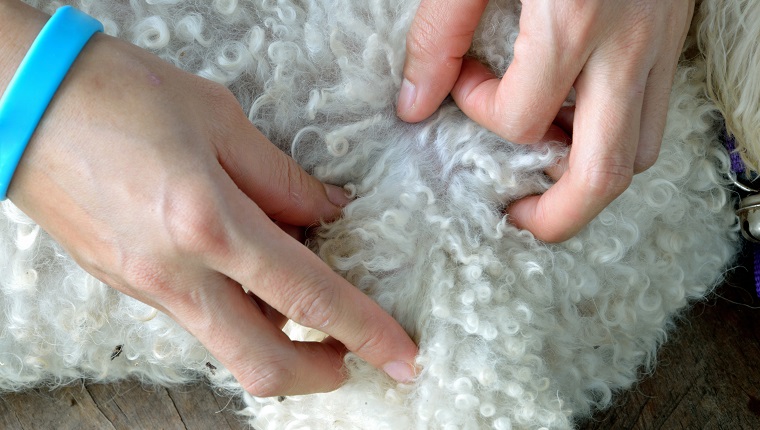Tick season may already be underway where you live, or it may be coming up soon. That can be dangerous for both dogs and people.
Ticks aren’t just a nuisance; they carry diseases that can sometimes cause major sickness and even death. The tick seasons of the past few years have been especially rough. Tick populations and instances of tick-borne illnesses are on the rise.
It’s important that you know how to keep your dog safe from ticks and their bites by learning what to watch out for where you live, how to avoid ticks, and what to do if you find a tick on your dog.
The time of the year that we refer to as “tick season” can vary based on where you live. For example, tick season can last all year long on the west coast of the United States from Washington to California, as well as states in the south and southeast parts of the country. Farther north, tick season lasts from early spring to late fall.
It’s important to stay vigilant, especially during your region’s tick season, to make sure your dog is safe and tick-free.
Why Ticks & Tick-Borne Illnesses Are On The Rise

Tick season has gotten worse over the past few years. There are several reasons that tick populations have increased, encounters between dogs and ticks are more frequent, and instances of tick-borne illnesses are more common.
As of 2021, nine out of the last ten years made it into the top ten warmest years on record globally. For the United States, that means milder winters and longer summers, which leads to an increase in availability of food for animals that ticks rely on for survival.
The population of animals, particularly rodents, goes up, too. That leads to more food for ticks, so their population increases, as well. More ticks mean more tick bites and diseases.
You might not expect the events of 200 years ago to still affect the tick population today, but there’s an interesting reason that European settlers are partially responsible for the surge in ticks.
Back then, areas like the Hudson River Valley in upstate New York were covered in forests. Settlers cut down many of the trees to make room for farms, build ships, and harvest firewood. Now, many of the trees have grown back but in patches instead of full forests.
Predators rely on large forests to survive. Small, patchy forests mean that prey like mice can thrive because predators are scarce, and the tick populations that feed on those prey animals also grow.
As people build their homes next to these tick-infested forests, the chances for humans and their pets to get bitten becomes much higher.
In coming years, the problem is likely to only get worse.
Tick-Borne Illnesses

Lyme Disease
The most well-known disease carried by ticks may be Lyme, which infects dogs and humans.
A rash usually forms around the bite, but not always. Eventually, fever, headache, and lethargy appear followed by more serious symptoms like inability to move parts of the face, joint pains, heart palpitations, and memory problems.
Lyme is spread by blacklegged ticks — also known as deer ticks — as well as western blacklegged ticks.
Rocky Mountain Spotted Fever
Another well-known disease spread by ticks is Rocky Mountain spotted fever.
Symptoms include headaches, lethargy, abdominal pain, and vomiting. It can prove fatal within a few days if left untreated.
The disease is spread by American dog ticks, brown dog ticks, and Rocky Mountain wood ticks.
Tularemia
Tularemia can be ulcerglandular or glandular.
Ulcerglandular tularemia results in an ulcer forming around the tick bite and swollen lymph glands.
Glandular tularemia is similar, but appears without an ulcer.
Both forms come with a high fever and can be life-threatening. They’re spread by the American dog tick, the Lone Star tick, and the Rocky Mountain wood tick.
Anaplasmosis
Anaplasmosis causes joint pain, lethargy, high fever, vomiting, diarrhea, and sometimes nosebleeds and seizures. It’s mostly not life-threatening, though it is carried by many types of ticks.
Blacklegged ticks, Rocky Mountain wood ticks, and western blacklegged wood ticks all spread anaplasmosis.
Powassan
A disease that has been getting a lot of attention recently is Powassan.
This virus isn’t common, but in humans, it can be devastating. Half of people who get the disease are permanently affected with chronic headaches, muscle wasting, and poor memory. Ten percent of people who get it die.
No known cases have been reported in dogs, though that may be due to a lack of testing. Take precautions to avoid it, as with any tick-borne disease.
Powassan is spread by blacklegged ticks.
Most At-Risk Dogs & People

Different species of ticks can be found all over the United States, though some species tend to be found in specific regions. It’s important to know which kinds of ticks live near you, which kinds of diseases they carry, and when ticks are most likely to appear in your region.
The blacklegged tick, or deer tick, is the one most often feared because it can carry Lyme and Powassan. While Powassan has not been found in dogs, Lyme can infect both humans and dogs alike.
These ticks can be found from the northeastern United states through the southeast, as well as around the Great Lakes region, especially Wisconsin where instances of Lyme are high.
The western blacklegged tick, which can also carry Lyme disease, is found all along the west coast of the United States and into Utah. Northern California has a high number of Lyme disease cases reported.
If you don’t live in one of the regions already mentioned, you’re not out of the woods. Ticks that carry Rocky Mountain spotted fever can be found all over the country.
Those who live near wooded areas, especially those in the northeast and Great Lakes areas, as well as marshy areas near oceans and other bodies of water should be careful.
Take Precautions Against Ticks No Matter Where You Live

Because recent years have seen an increase in tick populations, we’re also bound to see the areas that they cover expand. Instances of Lyme disease have gone up in the past several years, and the trend may continue this year.
Here are a few precautions every pet parent should take:
- When your dog goes out or if you take them for a walk, always check for ticks when they come back inside.
- Ask your veterinarian if a Lyme vaccination is right for your dog. If you are against vaccinating your dog, talk to your vet about other solutions to keep ticks and Lyme disease away from your pup.
- No matter where you live, if you plan on camping or hiking with your dog, you’ll need to do a full body inspection every day, and pay special attention to the ears, face, and inner thighs. The bugs like to live on vegetation and tall grass where they can attach to a passing animal, as well as in leaf piles.
- Ticks can even live indoors, though it’s less common to get bitten by a tick inside. Still, it can happen, and many dogs get bitten by ticks indoors during cold weather as the bugs move inside for warmth. Stay vigilant, even when the temperature cools off.
Avoiding Ticks

There are a few things you can do to reduce the chances that your dog will get bitten by ticks.
First, perform regular inspections of your dog’s skin. Ticks are unfortunately easiest to spot when they’ve already become engorged with blood after a bite, and they can be the size of the head of a pin when they haven’t feasted.
Using a comb to get deep beneath your dog’s coat will help with your inspection and may actually comb the ticks out if they aren’t attached.
Mowing your grass and keeping vegetation low in your dog’s outdoor area may also help, as ticks climb high to improve their chances of attaching to an animal.
Some people use pet-friendly pesticides, but since ticks live much of their life cycle underground, these may only provide temporary help.
Topical tick medications can be used to kill off ticks that bite your dog, and they’ll fall off by themselves. These are placed on the back of your dog’s neck. The effects usually last for a month to several months depending on the medication.
There are, however, potential side effects that you should be aware of, and some question whether these medicines are toxic to dogs, choosing to go with natural solutions, instead. You should research for yourself and talk to your vet about what options work for you and your dog.
Sprays, powders, shampoos, and collars can also be used to fight off ticks. All have their pros and cons, so it’s important that you learn about them and decide on a plan with your vet.
Whatever you decide, you should wash your dog’s bedding thoroughly from time to time. That helps to destroy any eggs and disrupt ticks’ life cycles.
Removing Ticks

If you do happen to find a tick on your dog, it’s important that you know how to remove it.
There is a rumor that using a match to remove a tick is the best way. However, you are more likely to end up burning your dog’s skin than removing the tick.
Instead, follow these steps to make sure you’re removing the tick from your dog’s skin properly:
- Clean the area surrounding the tick with alcohol.
- Use tweezers to grab the tick by the head, not the body.
- Pull upwards until the tick detaches. Some vets advocate turning the tick clockwise if it has burrowed deeply into the skin.
- If you pull the tick off, but the head is still attached to your dog’s skin, don’t worry. The head will most likely fall out on its own.
- Clean the area to prevent infection, and you can always consult your vet if you’re still worried.
- Once the tick is removed, do not crush it, as the blood it carries can be dangerous and harbor disease. Also, do not flush it down the toilet, as it can potentially crawl back out. Ticks are resilient.
- Instead, put the tick in a closed jar and drown it with alcohol. Your vet may ask you to keep any ticks that you’ve found on your dog for testing. That’s especially likely if it’s a species known to carry Lyme and your dog hasn’t been vaccinated.
Keep your dog and yourself safe this tick season. It’s bound to be a rough one.
What other ways do you keep your dog safe from ticks? Are you concerned about the tick population this year? Let us know in the comments below!









